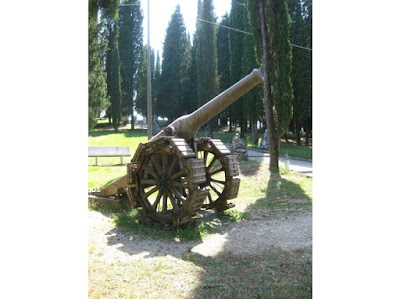Finding Mussolini
The Touch of Mussolini
Battle Memorial Fogliano Redipuglia
Between Venezia and Trieste is an important memorial dedicated to the men of the Italian army who fought in World War I. If you ask an Italian a question using the words “World War I”, they won’t know what you are talking about. They call this the “Grande Guerra”, or great war. Every village and town in Italy has a large plaque or memorial that has the names of the men who lost their lives in The Great War. The names listed in my village shows that some families lost 3 or 4 men.
Between Venezia and Trieste is an important memorial dedicated to the men of the Italian army who fought in World War I. If you ask an Italian a question using the words “World War I”, they won’t know what you are talking about. They call this the “Grande Guerra”, or great war. Every village and town in Italy has a large plaque or memorial that has the names of the men who lost their lives in The Great War. The names listed in my village shows that some families lost 3 or 4 men.
Carefully looking on the north side of the autostrada towards Trieste you will see a large cement structure as you drive by, but it is really better to exit off Via Terza Armata, near A4 Highway and take advantage of a free visit. The monument was ordered by Mussolini to be built in1938 and contains the bodies of 39,857 identified Italian soldiers, with 69,330 unidentified. Another cemetery close by has 14,000 Austro-Hungarian soldiers. The structure was also built to memorialise the Battle of Caporetto, a huge defeat where over 11.000 Italians were killed, 265,000 captured and 20,000 wounded.
 |
| View from parking lot |
Two famous people were involved in the war here. The first was Ernest Hemmingway drove an ambulance for the Italians, while the second on the other side was Erwin Rommel, then a junior officer. The last battle at the end of the war was called the Battle of Vittorio Veneto, and it brought an end to Italy’s war with the Austro-Hungarian Empire.
It’s quite a hike but you are permitted to climb to the top of the monument. Trench fortifications can be seen next to the war memorial, as well as a display of large WWI artillery pieces. (On a hot day, take a water bottle.)
Surrounding the parking area are many artillery weapons are placed in a shady park. Cannons of many sizes, and other armoured weapons can be seen along the dirt pathways. At the edge of the parking lot one can find a restaurant/bar serving cold drinks,etc.
The battle lines were in this area and the Hungarians won a huge battle and routed the Italian line and pushed forward toward Treviso. Here the lines finally held and were stabilized. About a year later the Italians pushed back with the help of British Artillery and the lines went back to closely where they had previously been established. After the war, the Allies decided to punish Austria and gave the city and the area around Trieste to the Italians, thus cutting off all water access for shipping. The Italians did not really use the port of Trieste which threw the city into a state of economic despair. Now, however, the busy port is partially shared by Slovenia.
 |
| Created By A Soldier |
The residents of Trieste speak Italian but many know German and Slovenian quite well. The food in this area can be of both styles, but is mostly Italian. However, once you cross the border into Slovenia you will find more of a type of German fare.
Following the coast around Trieste we like to visit the small town of Muggia for a leisurely lunch. There are two dock side restaurants located next to the main parking lot in the center of Muggia. The fish served here are right off the boat, and I recommend both restaurants. One has a nice area directly over the water and has a good menu featuring loads of appetizers. The other, found up a set of stairs onto a large area over the dock, is run by fishing boat owners and so you know the fish will be fresh. Perched on the second floor balcony, the view across the blue water towards Trieste is beautiful.





Comments